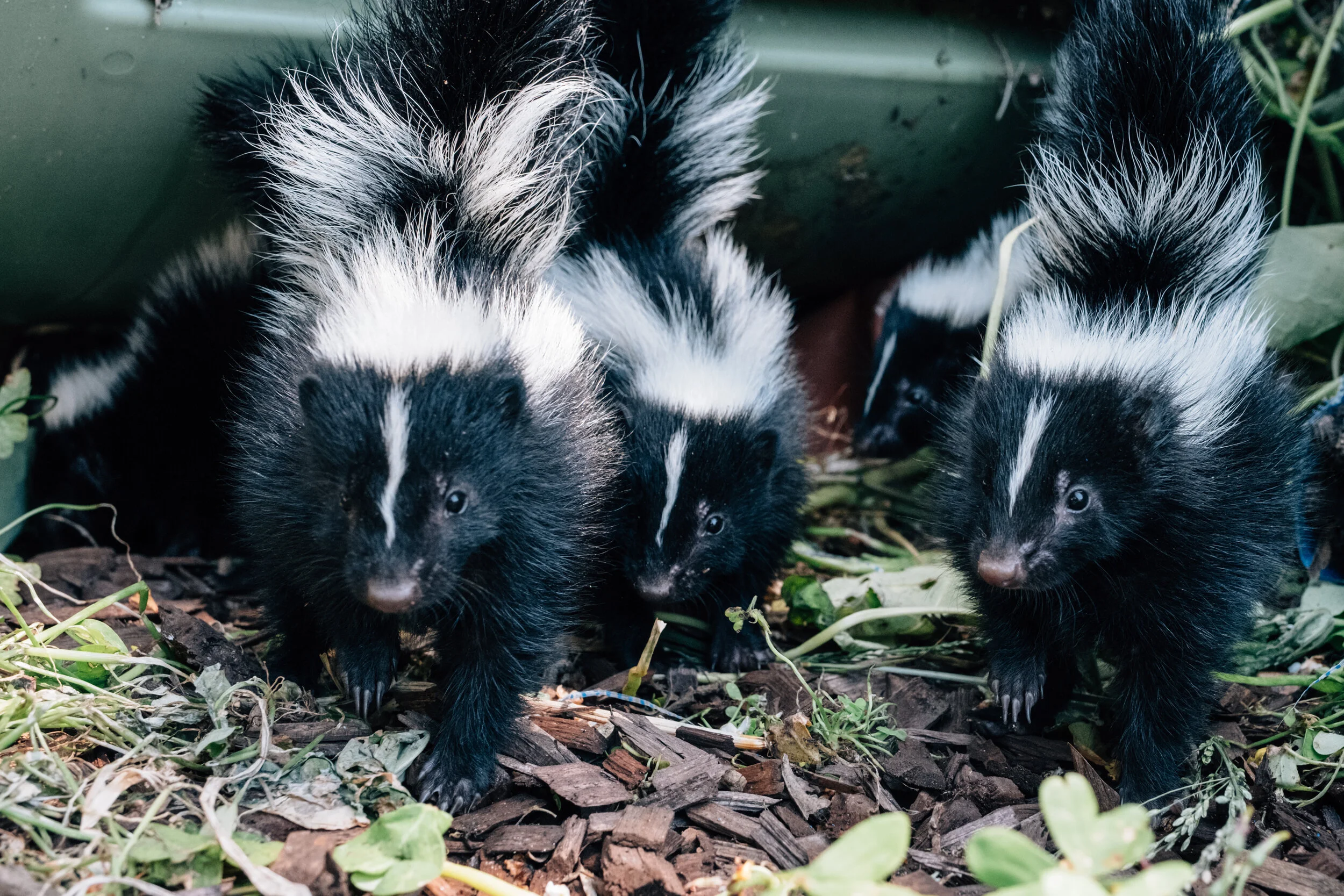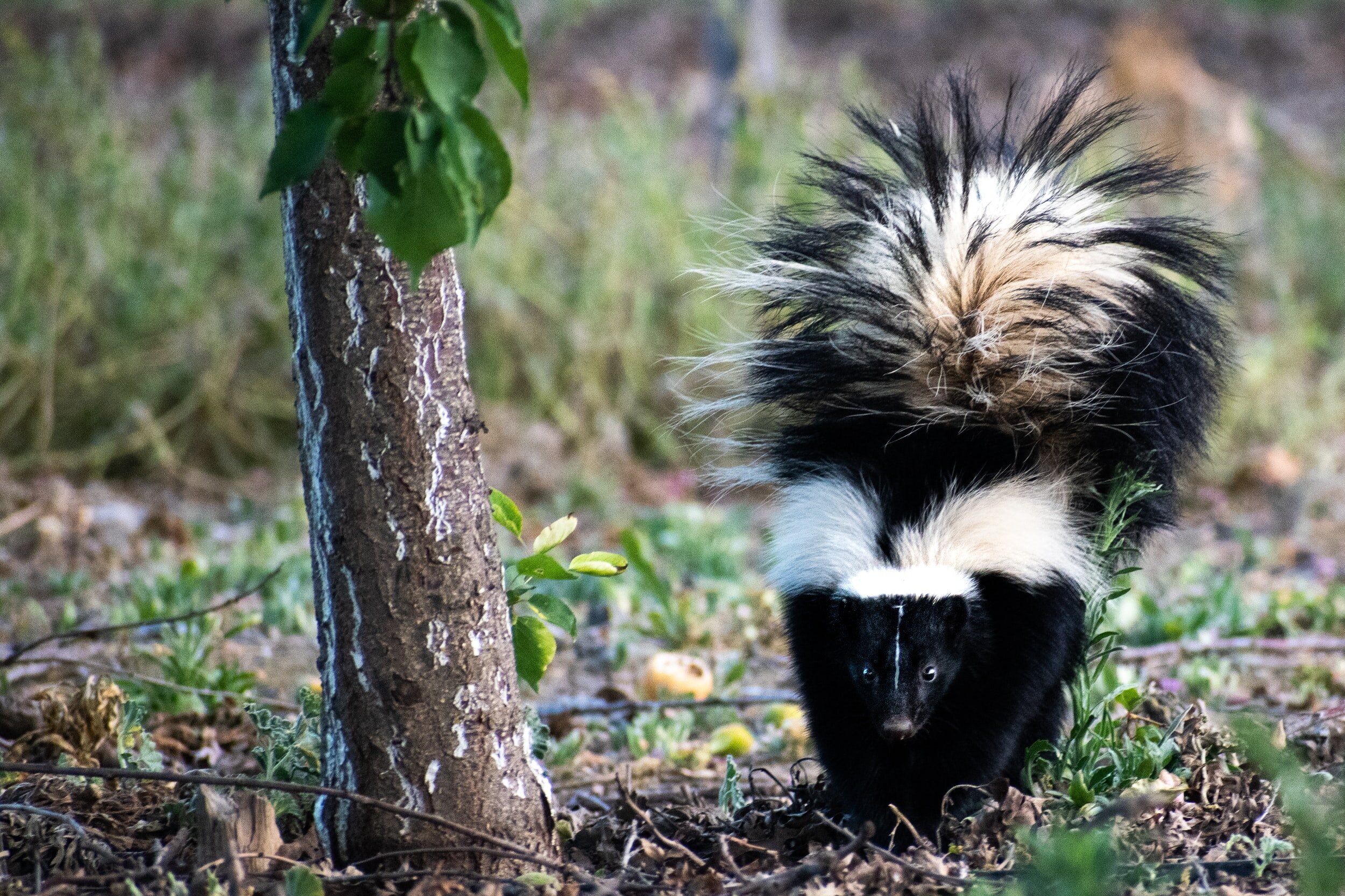
LIVING IN HARMONY WITH SKUNKS
IF YOU ENCOUNTER A SKUNK:
Do not startle it.
Talk softly so they know where you are and can avoid you.
Back away slowly.
Keep children and pets away.
Do not get between a mother and her babies.
Sometimes young skunks explore in the daytime while their mother is asleep. Unless they look injured or sick, they are probably fine.
IF A SKUNK NEEDS HELP:
Since skunks have the potential to spread rabies, do not handle the animal yourself. Call the Santa Barbara Wildlife Care Network and a vaccinated professional will rescue the skunk: (805) 681-1080
You can also call Santa Barbara County Animal Services: (805) 681-5285 or Santa Barbara City Animal Control: (805) 963-1513
GENERAL TIPS:
Do not touch it! Skunks are a rabies vector species.
Do not leave pet food outside.
Keep your pets indoors.
Make sure your trash cans have tight lids and are secured so they cannot be knocked over.
Put heavy gauge mesh on vents, openings to structures, and under sheds to prevent denning.
Pick up fallen fruit. Try to pick ripe fruit off of trees.
Do not leave windows or sliding doors without screens open or unattended.
Close garage doors.
Never intentionally feed a wild animal! Feeding wildlife increases human encounters, which endangers animals and harms the ecosystem.

SKUNK FAQ
-
Try not to scare the skunk. That is the best way to avoid being sprayed.
Do not get close to the skunk. They can spray up to 10 feet away. Additionally, avoid making loud noises to scare it. Try talking to it in a normal volume when approaching a skunk or turning on lights to alert the skunk of your presence.
Keep all pets inside and away from the skunk.
-
To get rid of the smell, use this home remedy (you can halve or double these measurements as necessary):
- One quart 3% hydrogen peroxide
- ¼ cup baking soda
- 1 teaspoon Dawn soap
- Mix all of the ingredients and then apply to your dog using either a cloth or spray bottle. Let the mixture sit for about 5 minutes, rinse, and that should diminish the stench.
To prevent your pet from being sprayed again, give skunks a warning by turning on a light and making some noise before letting your pet outside.
-
This is not an indication that the animal is unwell, it could be a mother taking a break from her babies to find food or rest a little. Winter and spring represent mating months for animals, meaning an increase in activity during the day. If an animal appears alert and active, it is best to leave them alone.
Many seemingly nocturnal animals, like skunks, opossums, and coyotes, are crepuscular, meaning they are most active at dawn and dusk. It is completely normal to see them at these times.
Juvenile animals may venture out of the den for the first time without their parents. This is normal, especially for young skunks.
If you believe the animal is sick or injured, call the Helpline: (805) 681-1080
-
Remove any garbage in the garage, leave the door open at dusk, and sprinkle flour at the exit to be able to check for prints, a sign that the animal has left. Use food, chicken or wet cat food to create a long trail out of the garage. Only close the door when you are positive the animal has exited.
Place a radio on a talk radio channel in the garage. Skunks are annoyed by constant human talking sounds.
Remove hiding places. Get things off the ground.
Once the animal is out, make sure that any holes or access points are sealed with wire mesh or another material with small holes.
-
Shine a bright light into their space. Skunks are nocturnal animals so this light will be disruptive to their natural rhythms.
Play a talk radio station near the den entrance. The sound of human voices is very threatening to skunks.
Soak rags in ammonia or apple cider vinegar and put them in a plastic bag. Then poke holes in the bag and place them near the entrance of the den.
Sprinkle flour thickly at the entrance of the den. The next day, look for paw prints. If you see paw prints exiting and not entering, it is safe to block off the entrance. This process can take a few days so be patient and watch the flour!
-
In summer and fall, skunks and other mammals may dig holes in lawns. To mitigate this, first identify the problem.
If there are sources of food, water or shelter, this will attract animals to your lawn. If possible, eliminate or block off these food, water, or shelter sources.
- Examples of food sources: pet food, seeds from bird feeders, fruit on fruit trees (tip: band fruit trees with sheet metal to prevent climbing animals)
- Examples of water sources: leaky pipes and hoses, pet water bowls, ground-level bird baths, koi ponds
- Examples of shelter sources: wood piles, shrubberies close to the ground, things that aren’t moved regularly (cars, boats, covered RVs, piles of junk)
If you have animals like skunks or gophers digging holes in your lawn, try using animal repellent. Humane options include cayenne pepper, Critter Ridder, and Shake-away.
If you see squirrels burying nuts in your yard, don’t be too worried; these holes are normally shallow and cannot cause too much damage.
-
1. Using a large blanket, approach the skunk in the trap. Talk in a low, constant voice and let the skunk know you are there.
2. Slowly lower the blanket over the skunk and the trap. Work at the opposite end of the trap to release it and let the skunk free. Lift the towel and leave, allowing the skunk to feel safe leaving.
3. If the skunk is visibly injured and does not appear to be able to move away, call Santa Barbara Wildlife Care Network.
In the future, do not set traps. See below for more information on trapping animals.
-
Live-trapping and relocation is inhumane. If animals are introduced into areas they are unfamiliar with, they do not know where food, water, or shelter sources are. There may be other animals in the area that have diseases to which the introduced animal has never been exposed. The introduced animal may be encroaching on another's territory.
Trapping is only a temporary solution. The reasons animals are visiting your property must be addressed before they stop visiting. If you get rid of one, another will simply take its place.
Traps often do not catch the intended targets. Other animals, including pets, are just as likely to enter traps set for skunks. Animals caught in traps often injure themselves trying to escape.
